 If I had to choose the most difficult strategy to use a side deck with, I’d choose Lightsworn. Unlike most decks, which strive to improve each matchup after side decking, Lightsworn duelists should often be content just ensuring that their matchup hasn’t worsened after doing so. There are several amazing cards against Lightsworn, including Light-Imprisoning Mirror and Skill Drain, which can completely cripple a Lightsworn deck if not addressed quickly. Monster destruction cards like Lightning Vortex and Bottomless Trap Hole are also damaging to the typical Lightsworn player, who relies on swarming the field and keeping Lightsworn monsters in the graveyard.
If I had to choose the most difficult strategy to use a side deck with, I’d choose Lightsworn. Unlike most decks, which strive to improve each matchup after side decking, Lightsworn duelists should often be content just ensuring that their matchup hasn’t worsened after doing so. There are several amazing cards against Lightsworn, including Light-Imprisoning Mirror and Skill Drain, which can completely cripple a Lightsworn deck if not addressed quickly. Monster destruction cards like Lightning Vortex and Bottomless Trap Hole are also damaging to the typical Lightsworn player, who relies on swarming the field and keeping Lightsworn monsters in the graveyard.
These cards have seen heavy play in Top 16 side decks at recent Shonen Jump Championships, posing some challenges to Lightsworn duelists in games 2 and 3 of each match. Furthermore, the extremely focused strategy that Lightsworn decks have, reliant on sending cards from the deck to the graveyard, makes it difficult to add tech without sacrificing the deck’s consistency or ability to explode into early victory.
In general, a Lightsworn player will send a lot more cards from the top of his or her deck to the graveyard than that player will draw in any given game. When sending cards from the top of the deck to the graveyard, Lightsworn duelists are usually hoping to send Necro Gardna, Plaguespreader Zombie, or Wulf, Lightsworn Beast to the graveyard. Often, they’re even happy to send any Lightsworn monsters, to turn Judgment Dragon and Lumina, Lightsworn Summoner into deadlier cards. Sometimes even sending Judgment Dragon to the graveyard is a good thing, as it can be retrieved with Monster Reincarnation or Beckoning Light.
So what cards aren’t Lightsworn players happy to see sent to the graveyard? Spells and traps. Once sent there, most Lightsworn players have no way to take advantage of them. This poses quite a challenge when side decking, since the most effective tech against several decks in the current metagames often comes in the form of spells and traps.
As a result, some Lightsworn players avoid playing a lot of added tech in games 2 and 3, and stuck with the central strategy that remains strong from game 1. But that doesn’t belittle the importance of the side deck for Lightsworn players at all. These players still must find a way to combat well-prepared opponents’ side deck strategies, since Light-Imprisoning Mirror and Skill Drain are particularly damaging. Also, most players main deck a few tech cards that can readily be removed for some Lightsworn tech.
When using Lightsworn, I’ve found that the deck runs best when side decking just a few cards for each matchup and being prepared against every deck, rather than side decking several cards for any particular matchup. This way, the natural synergy that makes the main deck so competitive goes untouched throughout the entire match. In this article, I will discuss the several different approaches you can take when side decking with a Lightsworn deck. The first of these approaches is my favorite, and against several decks, I believe that it is the most effective way to side deck using Lightsworn.
Counter Counter
This strategy has nothing to do with the card Counter Counter, but the name explains exactly what this side deck strategy is about: countering the opponent’s own side decking plans, which were designed to counter your main deck strategy. Most players have no problem adding several tech cards to their decks in games 2 and 3 to take down Lightsworn. Fortunately, you know that the majority of these cards are traps. This enables you to anticipate what your opponent will side deck, and prevent it from scoring your opponent a victory.
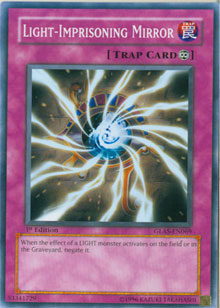 is one of my favorite cards used to nullify an anticipated side deck strategy against Lightsworn. Most importantly, it negates Light-Imprisoning Mirror, which almost every deck other than opposing Lightsworn builds can side deck effectively. It also negates Skill Drain and Royal Oppression, which are popular cards in several side decks (including some TeleDAD side decks) and most anti-meta variants. Royal Decree also helps to negate Bottomless Trap Hole, Mirror Force, and Torrential Tribute. All of these traps are extremely strong against Lightsworn, since they counteract the Lightsworn swarm strategy. Even the occasionally used Macro Cosmos can be devastating, since Lightsworn players are heavily reliant on their graveyards to win each duel. Fortunately, Royal Decree negates that too. With Royal Decree on the field, nearly all of your greatest concerns as a Lightsworn duelist are nullified, so you don’t need to be too worried about overextending your field or your entire strategy being shut down by a single card.
is one of my favorite cards used to nullify an anticipated side deck strategy against Lightsworn. Most importantly, it negates Light-Imprisoning Mirror, which almost every deck other than opposing Lightsworn builds can side deck effectively. It also negates Skill Drain and Royal Oppression, which are popular cards in several side decks (including some TeleDAD side decks) and most anti-meta variants. Royal Decree also helps to negate Bottomless Trap Hole, Mirror Force, and Torrential Tribute. All of these traps are extremely strong against Lightsworn, since they counteract the Lightsworn swarm strategy. Even the occasionally used Macro Cosmos can be devastating, since Lightsworn players are heavily reliant on their graveyards to win each duel. Fortunately, Royal Decree negates that too. With Royal Decree on the field, nearly all of your greatest concerns as a Lightsworn duelist are nullified, so you don’t need to be too worried about overextending your field or your entire strategy being shut down by a single card.
Similar to
Royal Decree,
Malevolent Catastrophe can also get rid of opposing traps before they put you in a difficult position. While
Malevolent Catastrophe doesn’t negate the cards played after its activation, it does destroy all of the spells and traps on the field when it’s used. This means that, unlike
Royal Decree, it doesn’t become a target that the opponent just needs to destroy in order to make all of his or her anti-Lightsworn tech work again. This is particularly important against Gladiator Beasts, which can tag in
Gladiator Beast Bestiari rather easily to destroy
Royal Decree.
Malevolent Catastrophe can also destroy spell cards too. This is important if you need to get rid of a rarely encountered
Dimensional Fissure, which
Royal Decree can’t stand up to, or even if you want to destroy some less commonly played quick-play spell cards like
Shrink and
Enemy Controller. The drawback of
Malevolent Catastrophe, which destroys all of your spell and trap cards too, is usually insignificant for Lightsworn duelists, since most Lightsworn players run so few trap cards, and the ones that they do run are often chainable.
Unfortunately, both
Royal Decree and
Malevolent Catastrophe are trap cards. This means that they must be set for one turn before they can be activated. For an aggressive swarm deck like Lightsworn, this is a huge disadvantage. As a result, many Lightsworn players opt to side deck faster magic and trap removal. Cards like
Heavy Storm,
Mystical Space Typhoon, and
Breaker the Magical Warrior can be used to destroy a trap card as soon as they are drawn, allowing for the immediate destruction of
Light-Imprisoning Mirror. Phantom of Chaos can do the same, by copying the effect of
Lyla, Lightsworn Sorceress or
Judgment Dragon. In
Shonen Jump Championship Detroit, Rob Cedar even side decked two copies of
Mobius the Frost Monarch with his Lightsworn deck, alongside his three side-decked copies of
Royal Decree and single copies of
Mystical Space Typhoon,
Heavy Storm, and
Breaker the Magical Warrior. He understood the importance of destroying the opponent’s trap cards after side decking, and was well-prepared to play against any opponent with a side deck teched to beat him.
Other Tech
As I mentioned earlier, playing additional tech can cause disappointing end phase effects from Lightsworn when spells and traps are sent to the graveyard instead of monsters. That’s why I believe that only the tech choices that provide a very significant edge when drawn (with the exception of spell and trap removal) are worth siding in. Tech is easiest to add in for the Lightsworn mirror match, since you don’t need to side in spell and trap removal. You know that your Lightsworn opponent can’t effectively side
Light-Imprisoning Mirror or
Skill Drain — two cards that your deck would need to side against for nearly any other matchup.
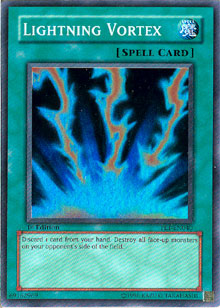 , for instance, is an incredible card in the Lightsworn mirror match, certainly worth playing. In the mirror match, both players can swarm the field quickly, and the player who can break through all of the opponent’s monsters to get in direct attacks will often win, since Lightsworn players usually put up little defense. In addition, the discard cost attached to Lightning Vortex is less significant for Lightsworn players than most others, since they often draw copies of Wulf, Lightsworn Beast, Necro Gardna, and Plaguespreader Zombie, which have little use in the hand.
, for instance, is an incredible card in the Lightsworn mirror match, certainly worth playing. In the mirror match, both players can swarm the field quickly, and the player who can break through all of the opponent’s monsters to get in direct attacks will often win, since Lightsworn players usually put up little defense. In addition, the discard cost attached to Lightning Vortex is less significant for Lightsworn players than most others, since they often draw copies of Wulf, Lightsworn Beast, Necro Gardna, and Plaguespreader Zombie, which have little use in the hand.
Celestia, Lightsworn Angel is also a strong card in the Lightsworn mirror match, and since it shares the Lightsworn name, it can be sided in without sacrificing the deck’s synergy. While Celestia can sometimes be a useless card to draw, in the Lightsworn mirror match, where your opponent most likely has no card to negate the summon or effect of Celestia (My Body as a Shield seems to have faded out of popularity), destroying two cards on the field and bringing out a 2300 ATK monster is game breaking. As a result, I believe that it would be a good decision to play three copies of Celestia against opposing Lightsworn decks in games 2 and 3, even if there aren’t three copies in the main deck. Celestia is especially good when combined with Brain Control, a commonly used spell card in Lightsworn. When playing the mirror match, aggression is usually the key to winning. It’s important to take advantage of your opponent’s probable lack of defensive traps and inability to disrupt your plays. While the occasional Threatening Roar that is sometimes thrown into Lightsworn decks may throw off your momentum, it still leaves you with a field full of monsters, often difficult for the opponent to get rid of. In addition, those monsters can use their end phase effects to turn the graveyard into a live resource.
While other tech cards are also available to be used by Lightsworn duelists to combat other decks, like Anti-Spell Fragrance against TeleDAD and Bottomless Trap Hole against Gladiator Beasts and beatdown variants, Lightsworn decks do very well without them. If there’s room for these tech cards, they should definitely be considered, but if there isn’t, the consistency and strong synergy of the deck should not be sacrificed for them. Having solutions to the opponent’s continuous trap cards in games 2 and 3 should take higher priority.
Transformation Options
The coolest thing about Lightsworn decks is that, despite being such a focused strategy, there are options available to transform the deck entering games 2 and 3. One of the most interesting side deck strategies I’ve seen was used by Da Lee at Shonen Jump Championship Atlanta. Nobody disagrees that Secret Village of the Spellcasters has a game-breaking effect. Several duelists, however, claim that Spellcaster-type monsters simply aren’t good enough to enable Secret Village to see play. Lee, on the other hand, made use of Secret Village with nothing more than the Spellcaster lineup already played in Lightsworn, and proved those duelists wrong by reaching the Top 16.
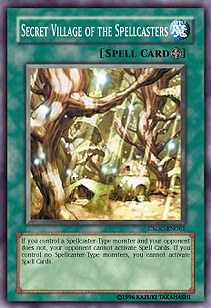 and Lumina, Lightsworn Summoner are both Spellcasters that can be played in threes and easily protected by Honest. They can also be searched out with Charge of the Light Brigade, so getting them onto the field is rarely a problem. Breaker the Magical Warrior, capable of destroying Light-Imprisoning Mirror, is another Spellcaster that can effectively be side decked in with Secret Village. With this entire team of Spellcasters, a Lightsworn duelist can effectively tap into the power of Secret Village of the Spellcasters when side decking against TeleDAD. Since TeleDAD is extremely dependent on spell cards to create combos and draw key cards, playing Secret Village early will allow a Lightsworn duelist to completely shut down a TeleDAD deck.
and Lumina, Lightsworn Summoner are both Spellcasters that can be played in threes and easily protected by Honest. They can also be searched out with Charge of the Light Brigade, so getting them onto the field is rarely a problem. Breaker the Magical Warrior, capable of destroying Light-Imprisoning Mirror, is another Spellcaster that can effectively be side decked in with Secret Village. With this entire team of Spellcasters, a Lightsworn duelist can effectively tap into the power of Secret Village of the Spellcasters when side decking against TeleDAD. Since TeleDAD is extremely dependent on spell cards to create combos and draw key cards, playing Secret Village early will allow a Lightsworn duelist to completely shut down a TeleDAD deck.
Another viable transformational side deck option for Lightsworn would be to change it into Twilight after game 1. While all of the Lightsworn monsters lose effects to Light-Imprisoning Mirror, Dark Armed Dragon does not share that common weakness. The Dragon can destroy the Mirror with its effect, and restore the Lightsworn monsters’ effects in turn. As Erin Diaz proved in Shonen Jump Championship Chicago when he made Top 8 with his Twilight deck, Twilight can be successful even without a lot of dedication to Dark monsters. Dark Armed Dragon, Phantom of Chaos, and Breaker the Magical Warrior are all Dark monsters that can fit right into a Lightsworn deck and destroy Light-Imprisoning Mirror. With Necro Gardna and even Plaguespreader Zombie in a typical Lightsworn build already, the requirement to summon Dark Armed Dragon is easily met. With Monster Reincarnation frequently played in Lightsworn decks as well, the graveyard becomes an incredible toolbox, capable of returning Dark Armed Dragon, one of the most feared monsters in the game. Better yet, that monster will be completely unexpected by your opponent, who thinks you’re running a pure Lightsworn deck and side decked accordingly.
So What Comes Out?
Deciding what cards to remove when side decking is often difficult, but there should always be a few cards that you know can safely be removed from the deck without ruining its structure.
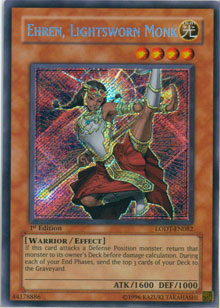 was once a very popular card because of her ability to send Gladiator Beast Hoplomus and Destiny Hero - Disk Commander back to the opponent’s deck, but in current metagames, she may not be as good in several matchups. Against Lightsworn, only the occasionally set Necro Gardna or Plaguespreader Zombie is worth sending back to the opponent’s deck, and TeleDAD rarely sets any defenses at all. The off chance of sending back the opponent’s one set Sangan in that matchup does not justify keeping this card in the deck during games 2 and 3 against a TeleDAD player.
was once a very popular card because of her ability to send Gladiator Beast Hoplomus and Destiny Hero - Disk Commander back to the opponent’s deck, but in current metagames, she may not be as good in several matchups. Against Lightsworn, only the occasionally set Necro Gardna or Plaguespreader Zombie is worth sending back to the opponent’s deck, and TeleDAD rarely sets any defenses at all. The off chance of sending back the opponent’s one set Sangan in that matchup does not justify keeping this card in the deck during games 2 and 3 against a TeleDAD player.
In the Lightsworn mirror match, where aggression is usually the key to winning, Ryko, Lightsworn Hunter is a slow card. Ryko can be destroyed by Celestia, Lightsworn Angel or Judgment Dragon before ever getting to use its effect, and it only has 200 ATK points, detaching it from the preferred Lightsworn aggression. Its versatility to destroy any one card once made it very strong, but in a fast match where face-down monsters are constantly destroyed to score direct hits, Ryko’s playability is limited. Lyla, Lightsworn Sorceress is also not very effective in the Lightsworn mirror match. While her 1700 ATK is enough to make her a decent draw against Lightsworn, the fact that that most popular Lightsworn decks run only chainable traps, really limits her effect. The drawback of switching her to defense mode while trying to promote an aggressive strategy also restricts her usefulness in the Lightsworn mirror match. While three copies of Lyla is great against a TeleDAD deck since she can destroy Solemn Judgment and Mirror Force, it’s simply too many against a Lightsworn deck.
In the TeleDAD matchup, Ryko’s effect can be negated by Stardust Dragon. While it’s true that several TeleDAD players prefer to summon Colossal Fighter in the Lightsworn matchup because of Honest, they won’t bring him out if they suspect you control Ryko. Against TeleDAD, it’s a good idea to have a variety of plays ready to destroy either Stardust Dragon or Colossal Fighter. You should have some copies of Ryko and/or Celestia in your deck in case you need to destroy Colossal Fighter, but not so many that you get cluttered with dead draws when the opponent summons Stardust Dragon. I prefer a single copy of Ryko against TeleDAD, since it can be searched out with Charge of the Light Brigade if needed.
When side decking, it’s also important to keep in mind the strengths of Charge of the Light Brigade and Judgment Dragon. Arguably two of the best cards in the deck, both of them rely on running a variety of Lightsworn monsters to make the best use of them. Running several different Lightsworn increases the toolbox that Charge creates, and makes it easier to get four different names in the graveyard to satisfy the summoning condition of Judgment Dragon. As a result, it’s important not to remove too many different Lightsworn monsters when side decking. For instance, if you remove all copies of Jain, Lightsworn Paladin, Ehren, Lightsworn Monk, and Ryko, Lightsworn Hunter just because none of them are critical to the deck independently, you’ll find it difficult to summon Judgment Dragon and get limited use out of Charge of the Light Brigade. This weakens some of the best cards that the Lightsworn deck has to offer. Be careful of this when side decking, and try to keep at least six different Lightsworn monsters in the deck at all times if you plan on using Judgment Dragon.
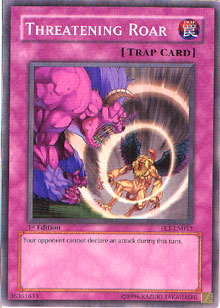 Other cards that aren’t theme-specific can freely be removed from the main deck and replaced with side deck tech. Phoenix Wing Wind Blast, Threatening Roar, Anti-Spell Fragrance, and Cold Wave are just a few cards that have recently been played in Top 16 Lightsworn main decks and can be removed when side decking without disrupting the Lightsworn strategy. This is often one of the safest approaches to take when side decking with Lightsworn, because the speed of the deck is not sacrificed. This strategy is particularly useful against the less popular decks in the metagame, like Gladiator Beasts, Zombies, and Oppression variants. The cards that can be side decked out against these decks are often cards that were only placed in the main deck in the first place to combat the most popular threats, TeleDAD and Lightsworn. Anti-Spell Fragrance, for instance, is extremely ineffective against Gladiator Beasts and Oppression variants, which are more reliant on trap cards and monster effects than spells. It’s also nearly useless against Lightsworn, since the deck runs so few spells and it’s difficult to keep Anti-Spell Fragrance on the field during a time the opponent will actually want to use spells. Similarly, Cold Wave is a weak card when used against a deck that activates as few spells and puts up as few trap defenses as Lightsworn, and Threatening Roar is unnecessary against a non-aggressive Royal Oppression variant.
Other cards that aren’t theme-specific can freely be removed from the main deck and replaced with side deck tech. Phoenix Wing Wind Blast, Threatening Roar, Anti-Spell Fragrance, and Cold Wave are just a few cards that have recently been played in Top 16 Lightsworn main decks and can be removed when side decking without disrupting the Lightsworn strategy. This is often one of the safest approaches to take when side decking with Lightsworn, because the speed of the deck is not sacrificed. This strategy is particularly useful against the less popular decks in the metagame, like Gladiator Beasts, Zombies, and Oppression variants. The cards that can be side decked out against these decks are often cards that were only placed in the main deck in the first place to combat the most popular threats, TeleDAD and Lightsworn. Anti-Spell Fragrance, for instance, is extremely ineffective against Gladiator Beasts and Oppression variants, which are more reliant on trap cards and monster effects than spells. It’s also nearly useless against Lightsworn, since the deck runs so few spells and it’s difficult to keep Anti-Spell Fragrance on the field during a time the opponent will actually want to use spells. Similarly, Cold Wave is a weak card when used against a deck that activates as few spells and puts up as few trap defenses as Lightsworn, and Threatening Roar is unnecessary against a non-aggressive Royal Oppression variant.
Conclusion
Side decking with Lightsworn isn’t always as clear-cut as side decking with certain other decks. There are several different strategies that can be used to help Lightsworn decks clinch victory in the second and third games of each match. Against an unprepared opponent who is unaware of the popularity of Lightsworn and not side decking anything to beat it, you may not even want to use your side deck at all. In the end, even the greatest amount of side deck preparation will require you to make constant judgment calls between games to determine which cards you should side deck in and out for each opponent. It’s not always easy to know whether or not your opponent is prepared to face you and whether or not that player has strong trap cards like Light-Imprisoning Mirror or Skill Drain in his or her side deck.
The most important thing while side decking is to never lose sight of your objective as a Lightsworn duelist: win games quickly and destroy anything that stands in your way from doing so. As one of the fastest and most explosive decks in the format, Lightsworn decks are extremely difficult to take down. Side deck cards that can destroy your opponent’s side deck strategy will often create the difference between victory and defeat.
-Michael Kohanim